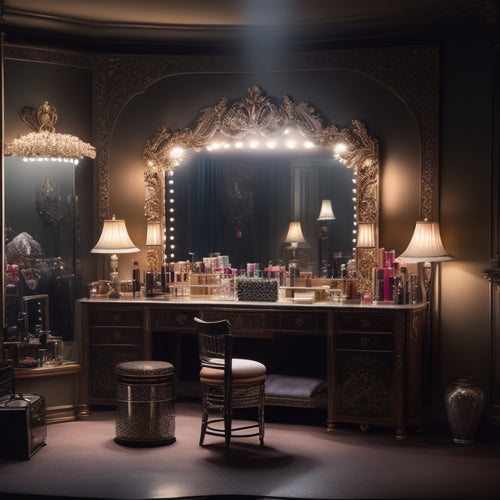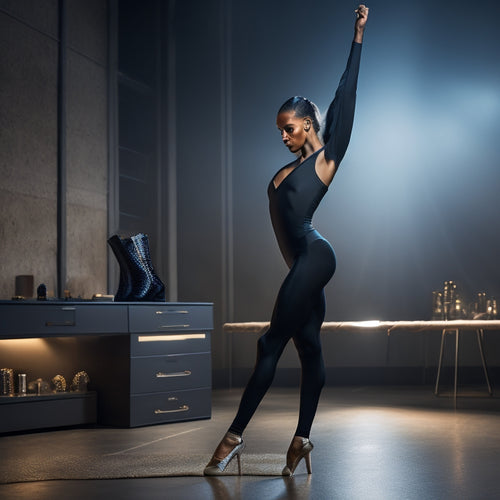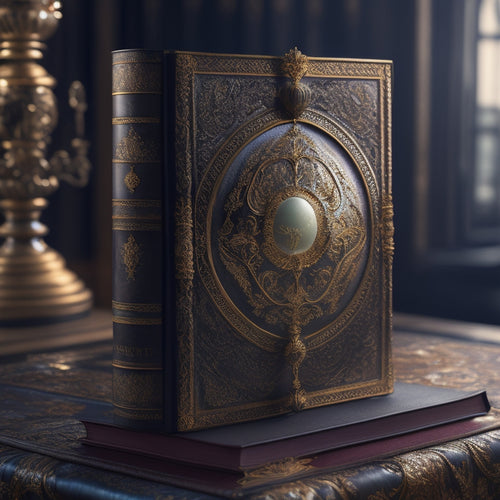
7 Tips for Stunning Performance Costume Design
Share
You're about to reveal the secrets to a show-stopping performance costume design that will leave your audience mesmerized. Start by defining your dance style, weaving a narrative through your costume that showcases your cultural heritage, personal experiences, and artistic expression. Next, choose fabrics that flex, flow, and shimmer, considering weight distribution for ease of movement. Balance color and contrast to create a visually stunning design, and strategically place sequins to guide the viewer's eye. As you continue to craft your costume, the possibilities will unfold, and your performance will come alive in ways you never thought possible.
Key Takeaways
• Define your dance style by fusing cultural heritage, personal experiences, and artistic expression through costume design.
• Choose fabrics that flex, flow, and shimmer, considering weight distribution and fabric type for ease of movement.
• Balance color and contrast by creating a palette that pops, blends, and contrasts, utilizing color blocking and texture.
• Strategically place sequins to guide the viewer's eye and craft a visual narrative, balancing sequin sizing for visual interest.
• Accentuate the right curves by using fabrics that hug the body, creating a defined silhouette with seams, darts, and gathering.
Defining Your Dance Style
As you step into the world of performance costume design, pinpointing your unique dance style is crucial, as it lays the foundation for the visual narrative that will unfold on stage.
Your dance style is a fusion of your cultural heritage, personal experiences, and artistic expression. It's the thread that weaves together the intricate tapestry of your performance.
As you explore your dance style, consider the cultural fusion that makes you unique. Perhaps you're a contemporary dancer with African roots, or a ballet dancer with Latin flair. Whatever your style, it's vital to own it and let it shine through your costume design.
Think about the personal expression you want to convey through your costume. Do you want to evoke emotions, tell a story, or make a statement? Your costume should be an extension of your dance style, not just a pretty accessory.
Selecting Fabrics for Movement
With your dance style defined, you're now ready to wrap your body in fabrics that not only make you look stunning but also allow for freedom of movement, so choose fabrics that flex, flow, and shimmer with every step, spin, and leap.
You want fabrics that drape elegantly, flowing with your movements like a river of silk. Look for fabrics with a smooth, lustrous finish that catches the light as you twirl and leap across the stage.
When selecting fabrics, consider the weight distribution of your costume. You don't want a heavy, cumbersome design that restricts your movements or puts unnecessary strain on your body. Opt for lightweight fabrics that provide a full range of motion, allowing you to focus on perfecting your craft.
For example, flowing chiffon or georgette fabrics are ideal for dramatic, sweeping movements, while stretchy lycra or spandex are perfect for high-energy, dynamic performances.
Balancing Color and Contrast
Paint your performance with a palette of colors that pop, blend, and contrast, carefully balancing hues to draw the audience's eye to your every move. As a costume designer, you're not just creating a look, you're crafting an emotional experience.
Color blocking is key to making your design pop. Divide your costume into sections, using bold colors to create visual interest. Consider creating a mood board to visualize your color palette and guarantee cohesion. Think about the mood you want to evoke and choose colors that align with it. Will you opt for calming pastels or bold, attention-grabbing hues?
Balance warm and cool tones to create visual harmony. Remember, contrast is key to making your design stand out. Experiment with different textures, fabrics, and embellishments to add depth and dimension. By thoughtfully balancing color and contrast, you'll create a visually stunning performance costume that captivates your audience.
Strategic Sequin Placement Matters
Sparkling sequins scattered thoughtlessly can overwhelm the senses, but strategically placed, they become a dynamic tool to accentuate movement, draw attention, and elevate your performance costume to dazzling heights.
When it comes to sequin placement, you're not just adding sparkle – you're crafting a visual narrative. To make the most of this dazzling embellishment, consider the following:
-
Sequin Sizing: Balance large sequins with smaller ones to create visual interest and avoid overwhelming the senses.
-
Embellishment Techniques: Experiment with different application methods, such as hotfix, flatback, or beading, to achieve the desired texture and dimension.
-
Sequin Placement: Strategically place sequins on areas of the costume that will be highlighted by movement, like the arms, legs, or shoulders, to create a mesmerizing effect.
- Visual Flow: Consider the overall visual flow of your costume and use sequins to guide the viewer's eye to key areas, like the face or hands.
Adding Dimension With Texture
As you've thoughtfully scattered sequins to accentuate movement, now it's time to add depth to your design by incorporating a variety of textures that tantalize the senses.
You want your costume to be a feast for the eyes, with a mix of smooth, rough, soft, and tactile elements that invite exploration. Furry accents can add a playful touch, while Velvet Depths can evoke luxury and sophistication.
Consider combining matte and shiny fabrics to create visual interest, or pairing smooth fabrics with rougher textures like burlap or lace. Don't be afraid to experiment with unconventional materials – like faux fur, ruffles, or even found objects – to add an extra layer of depth to your design.
Accentuating the Right Curves
With every fold, drape, and curve, your costume design should sculpt the wearer's form, accentuating their physique while creating an enthralling visual flow. As you craft your design, remember that accentuating the right curves is essential to creating a stunning performance costume. By emphasizing the wearer's natural silhouette, you can create a sense of movement and energy, even when they're standing still.
Here are some tips to help you accentuate the right curves:
-
Body Contouring:
Use fabrics that hug the body in all the right places, creating a flattering silhouette that emphasizes the wearer's curves. -
Silhouette Emphasis:
Use seams, darts, and gathering to create a defined silhouette that showcases the wearer's physique. -
Accentuate the Waist:
Highlight the narrowest part of the torso to create a sense of hourglass curves, even on those without a naturally curvy figure.
-
Balance Volume and Flow:
Balance voluminous fabrics with more fitted sections to create a sense of flow and movement.
Illuminating the Performance
Your costume design should burst forth with a visual narrative, painting the performance space with color, texture, and light to captivate the audience's imagination. Illuminating the performance is essential to creating an immersive experience. You want to guarantee your design shines, literally! Consider the Lighting Concepts that will enhance your costume's features. Will you use warm or cool tones to evoke emotions? Will you opt for spotlights to highlight specific details or floodlights to bathe the entire stage in light?
| Lighting Concepts | Stage Presence |
|---|---|
| Warm Tones | Cozy, Inviting Atmosphere |
| Cool Tones | Moody, Dramatic Effect |
| Spotlights | Accentuate Costume Details |
| Floodlights | Create a Sense of Grandeur |
| Black Light | Highlight Neon Accents |
Frequently Asked Questions
How Do I Ensure Costume Durability for Repeated Performances?
'Your costume is a treasure chest, overflowing with secrets waiting to be revealed. To keep it intact, you'll want to test fabrics for durability, simulate wear and tear, and establish laundry protocols to guarantee your treasure remains intact for repeated performances.'
Can I Use Everyday Clothing Items in My Costume Design?
You can repurpose everyday clothing items, infusing personal expression and cultural significance into your costume design, ensuring a unique, thought-provoking look that's both visually striking and safe to wear during performances.
What Is the Best Way to Attach Heavy Costume Pieces Securely?
When attaching heavy costume pieces, you'll want to guarantee they're secure and won't compromise your safety. Try using hot glue to bond materials or industrial magnets to create a strong, detachable hold that won't weigh you down.
How Do I Avoid Overwhelming the Audience With Too Much Sparkle?
Did you know 80% of audience members recall a show's visuals over its dialogue? To avoid overwhelming them with too much sparkle, you'll strike a balance by creating a visual hierarchy, prioritizing focal points and subtly incorporating sparkle to guide the audience's gaze.
Are There Any Safety Considerations for Costume Design?
When designing costumes, you guarantee safety by prioritizing flame resistance, especially for costumes near open flames or hot lights, and setting weight limits to prevent injuries from heavy or cumbersome pieces.
Related Posts
-

10 Essential Tips for Dance Makeup Entrepreneurs
As a dance makeup entrepreneur, you're ready to take your unique style to the next level. Define your brand's Unique ...
-

5 Dance Performance Apparel Must-Haves for a Flawless Routine
You rely on your dancewear to deliver a flawless performance, and that's exactly what it should do. Your dance perfor...
-

The King Manual: Your Ultimate Knowledge Companion
The King Manual: Your Ultimate Knowledge Companion is an all-encompassing resource that opens up the power of knowled...


